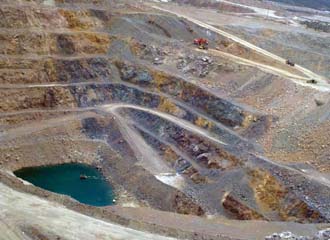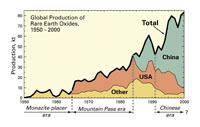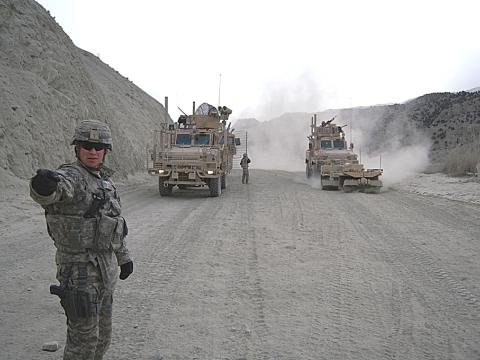Rare Earths to Become Less Scarce
The international mining community is racing to turn the tables on the People’s Republic of China by challenging its absolute dominance of the market for rare earths, a series of elements in the periodic table critical for the U.S. military’s high-technology communications and weaponry.
 |
|
Molycorp Incorporated’s Mountain Pass, California, mine, is one of the largest rare earth mines outside China. It recently reopened after being closed for about a decade. |
China’s newly gained monopoly may disappear by mid-decade.
The international mining community is racing to turn the tables on the People’s Republic of China by challenging its absolute dominance of the market for rare earths, a series of elements in the periodic table critical for the U.S. military’s high-technology communications and weaponry. Four new mines could be supplying U.S. military needs, along with those of other nations, in just a handful of years.
Over the past two years, China has placed increasing restraints on its exports of rare earths, which in turn has caused the price of many of these materials to more than double. In recent months, China has further restricted supplies by closing hundreds of independent mines alleged to have caused environmental damage. China sets the tone for this market simply based on the fact that it controls 97 percent of the world’s supply.
This in turn has given near-maniacal zeal to the drive to find supplies of rare earths outside the world’s most populous nation. Industry leaders and executives say several companies involved in rare-earth exploration and mining have discovered vast reserves that could shift the balance of power toward the West in as little as five years.
The U.S. military does not obtain any rare earths directly from China and is prohibited from doing so under federal law. Instead, the Defense Department buys components that include rare earths. These components often come from Japan, and they are used in a wide array of hardware, from missile guidance systems to fiber optic links to avionics.
Rare earths are a vital element in information technology circuitry. They also are particularly important for communications equipment. Used as an alloy in small but powerful magnets, rare earths have helped revolutionize miniaturization of electronics, industry experts note.
Peter Cashin, president and chief executive officer of Quest Rare Minerals Limited, says that to understand this market, it is important to draw a distinction between light and heavy rare earths. This latter category is more difficult to obtain in part because of the complexity of processing the materials.
“The Chinese are very impoverished in heavy rare earths,” says Cashin, whose company owns property with a massive deposit of rare earths in northeastern Canada. “They just don’t produce a lot of them.
“Military applications require 100 percent reliability,” he continues. “And heavies do that because they are more heat-resistant than the applications that use the light rare earths. The natural evolution of these technologies [led them to] build up a lot of heat, and that tends to be your most constraining factor.”
Cashin says he has seen renewed interest from industry and the U.S. military in obtaining stable, long-term North American supplies of rare earths. By the time his company’s Strange Lake mine opens in 2015-2016, he expects more restraints from China.
“I truly believe that in dealing with the Chinese, don’t take what they tell you at face value. React and form an opinion on the basis of their actions. They are trying to protect their turf, particularly in regards to their high-tech industries, those industries that use rare earths,” Cashin states.
Mark Saxon, chief executive officer of Tasman Metals Limited, a Canadian company with a large rare earth mine in Sweden, says Europeans in particular hope to have domestic sources by 2015. This is related to the fact that the 27-nation European Union (EU) is completely committed to fostering so-called green technology. Wind turbines and hybrid cars require vast amounts—literally tons—of these substances.
 |
Despite their need for rare earths, the Europeans continue to resist moving factories to China to obtain more stable supplies. Saxon says business and political leaders remain suspicious of the Chinese because of their reputation for stealing intellectual property.
“When you talk about Europe and the rare earths, you are really talking about Germany,” Saxon says. “Germany is by far the major consumer within the EU. And most of the manufacturing lines where significant intellectual property exists are still being done inside Germany.
“They are not prepared to lose their intellectual property,” he explains. “They see the real value in that. There certainly is a pushback against the Chinese. You can’t say it’s racism, but it is as strong as that. It’s a lack of trust, I suppose. And there is a lack of understanding about the [Chinese] culture.”
Noted mining analyst John Kaiser predicts prices will continue rising in the short term before moderating around the middle of the decade. In fact, he says, China actually could consume all its known deposits of rare earths by then, but it likely will continue some exports to avoid skirmishes with the World Trade Organization, which seeks to settle trade disputes.
“There is a contingent in China within the military that foolishly thinks it can use its rare earth monopoly as some sort of strategic advantage,” says Kaiser, editor of Kaiser Research Online. “But China actually needs the rest of the world to put their own deposits into production.
“If there is any growth in demand within China, there won’t be any available for export markets. Western users are in a pickle. They have to move their production capacity to China to get access to these materials. And that’s what everybody is upset about.”
But Kaiser remains optimistic that the Western world will solve its rare earth crisis. He has analyzed each of the four rare earth mines scheduled to come online in the next five years, and he believes they could supply all the Western world’s need for these elements.
One of those mines is a U.S. light rare earth facility owned by Molycorp Incorporated. Kaiser says that this is the company that Pentagon officials are watching the most closely. Then again, it is the only U.S. source of rare earths.
Molycorp has reopened a southern California mine that used to be a dominant global player in rare earths. That mine at Mountain Pass closed about a decade ago. Ironically, low prices from China factored in the decision by its previous owner to close the facility. A crackdown by state and federal environmental regulators also had a major impact on the decision.
Molycorp officials would seem to have a firm understanding of how the Pentagon makes its purchasing decisions. Charles R. Henry is a retired U.S. Army major general who serves on Molycorp’s board. From 1988 to 1992, Henry served as a top business general at the Pentagon. He managed contracts worth several billion dollars. He also has served as president and chief operating officer of CRH Incorporated, a consulting firm specializing in defense acquisition issues.
Molycorp officials intend to double production by 2013 to meet the growing U.S. demand. Thus, this domestic supplier is slated to have a major impact on the entire rare earth supply chain.
Another light rare earth mine is located in Australia. Owned by Lynas Corporation Limited of Sydney, the heart of the operation lies in western Australia where the company’s Mount Weld mine contains world-class deposits. Lynas hit a major milestone on May 14, 2011, when it fed the first crushed ore into a mill at its Australian concentration plant.
Lynas also received an investment worth around $200 million in July 2011 from a Thai-Japanese joint venture. The money was earmarked for expansion of an advanced processing plant under construction in Malaysia, which is due for completion in late 2012.
Lynas has remained in a spirited race with Molycorp to become the first new supplier of rare earths outside China. But Lynas also has faced questions about its ability to begin selling product in bulk by early 2012 because the company faced delays in the startup of the Malaysian plant. Lynas executives chose Malaysia because of the country’s readily available industrial infrastructure, including land, as well as sources of gas, water and electricity.
Despite that challenge, Lynas garnered a major vote of confidence from one of the world’s premier manufacturers. Lynas has formed a joint venture with Germany’s Siemens, specifically with that company’s drive technologies division. Under the agreement, the two companies will produce neodymium-based rare earth magnets that Siemens will use in drive trains and wind turbines. Siemens has a 55 percent ownership stake in the enterprise, and Lynas owns the remaining 45 percent.
In Canada, a small exploration company known as Quest Rare Minerals is concentrating on heavy rare earths. This firm formerly focused on scoping out deposits of uranium, which is highly associated with rare earths. But with the rebound in rare earth prices and the rising concern about China’s monopolistic control of the market, the company shifted strategies. It now owns what most experts considered by far the largest deposit of heavy rare earths in North America.
Already massive in scope, the Strange Lake project also has yielded discovery of a new belt of rare earth supplies referred to as the B-Zone. Adding to the economies of scale, the new tract lies less than two miles from the main project.
Depending on the location, heavy rare earths account for between 38 percent and 70 percent of its rare earths, company officials say. In June, the firm provided an update of its winter drilling program that showed yet another possible vein for mining in a sector known as the A-Zone. The new tract lies just about 1.8 miles south by southeast of the B-Zone deposit.
Although Strange Lake lies in a remote region of northeastern Canada, its overall proximity to the United States makes the mine strategically significant. And Quest executives say they have discovered rare earth deposits at their Misery Lake property, which is about 75 miles south of Quest’s Strange Lake project in northeastern Quebec.
Europe’s entry in the rare earths race is hosted by the Canadian firm Tasman Metals Limited. This company did not even exist before 2009. Of all the firms in this sector, Tasman has made the biggest entry, garnering global attention for its massive heavy rare earths deposit in southern Sweden not far from where rare earths were discovered about 225 years ago.
Tasman’s Norra Karr mine remains the continent’s most strategically important mine. And Tasman owns the only rare earth mine that complies with the stringent requirements of an international report called the 43-101. Mining industry officials consider that report the gold standard for estimating economically viable reserves.
Meanwhile, Tasman’s Norra Karr mine has another strategic advantage. It contains low amounts of thorium and uranium. That means the mine will not require special permits or monitoring for radioactivity, which will lower mining costs.
Tasman also has other rare earth projects to explore. These include the Bastnäs mine in Sweden and a mine in Finland that formerly was used for production of base metals.
WEB RESOURCES
Molycorp Incorporated: www.molycorp.com
Lynas Corporation Limited: www.lynascorp.com
Quest Rare Minerals Limited: www.questrareminerals.com
Tasman Metals Limited: www.tasmanmetals.com


